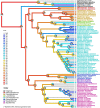Shark genome size evolution and its relationship with cellular, life-history, ecological, and diversity traits
- PMID: 38632352
- PMCID: PMC11024215
- DOI: 10.1038/s41598-024-59202-4
Shark genome size evolution and its relationship with cellular, life-history, ecological, and diversity traits
Abstract
Among vertebrates, sharks exhibit both large and heterogeneous genome sizes ranging from 2.86 to 17.05 pg. Aiming for a better understanding of the patterns and causalities of shark genome size evolution, we applied phylogenetic comparative methods to published genome-size estimates for 71 species representing the main phylogenetic lineages, life-histories and ecological traits. The sixfold range of genome size variation was strongly traceable throughout the phylogeny, with a major expansion preceding shark diversification during the late Paleozoic and an ancestral state (6.33 pg) close to the present-day average (6.72 pg). Subsequent deviations from this average occurred at higher rates in squalomorph than in galeomorph sharks and were unconnected to evolutionary changes in the karyotype architecture, which were dominated by descending disploidy events. Genome size was positively correlated with cell and nucleus sizes and negatively with metabolic rate. The metabolic constraints on increasing genome size also manifested at higher phenotypic scales, with large genomes associated with slow lifestyles and purely marine waters. Moreover, large genome sizes were also linked to non-placental reproductive modes, which may entail metabolically less demanding embryological developments. Contrary to ray-finned fishes, large genome size was associated neither with the taxonomic diversity of affected clades nor with low genetic diversity.
© 2024. The Author(s).
Conflict of interest statement
The authors declare no competing interests.
Figures




Similar articles
-
Elephant shark sequence reveals unique insights into the evolutionary history of vertebrate genes: A comparative analysis of the protocadherin cluster.Proc Natl Acad Sci U S A. 2008 Mar 11;105(10):3819-24. doi: 10.1073/pnas.0800398105. Epub 2008 Mar 4. Proc Natl Acad Sci U S A. 2008. PMID: 18319338 Free PMC article.
-
Sequential trait evolution did not drive deep-time diversification in sharks.Evolution. 2024 Jul 29;78(8):1405-1425. doi: 10.1093/evolut/qpae070. Evolution. 2024. PMID: 38745524
-
Evolution of reproductive modes in sharks and rays.J Evol Biol. 2023 Nov;36(11):1630-1640. doi: 10.1111/jeb.14231. Epub 2023 Oct 26. J Evol Biol. 2023. PMID: 37885147
-
Hox gene clusters of early vertebrates: do they serve as reliable markers for genome evolution?Genomics Proteomics Bioinformatics. 2011 Jun;9(3):97-103. doi: 10.1016/S1672-0229(11)60012-0. Genomics Proteomics Bioinformatics. 2011. PMID: 21802046 Free PMC article. Review.
-
Phylogenetic perspectives on reef fish functional traits.Biol Rev Camb Philos Soc. 2018 Feb;93(1):131-151. doi: 10.1111/brv.12336. Epub 2017 May 2. Biol Rev Camb Philos Soc. 2018. PMID: 28464469 Review.
References
-
- Klug S. Monophyly, phylogeny and systematic position of the †Synechodontiformes (Chondrichthyes, Neoselachii) Zool. Scr. 2009;39:37–49. doi: 10.1111/j.1463-6409.2009.00399.x. - DOI
-
- Pollerspöck, J. & Straube, N. Bibliography database of living/fossil sharks, rays and chimaeras (Chondrichthyes: Elasmobranchii, Holocephali)—List of valid extant species; list of described extant species; statistic. Version 08/2023. World Wide Web Electronic Publication. www.shark-references.com (2023).
-
- Pearce J, Fraser MW, Sequeira AMM, Kaur P. State of shark and ray genomics in an era of extinction. Front. Mar. Sci. 2021;8:415–421. doi: 10.3389/fmars.2021.744986. - DOI
MeSH terms
Grants and funding
LinkOut - more resources
Full Text Sources

